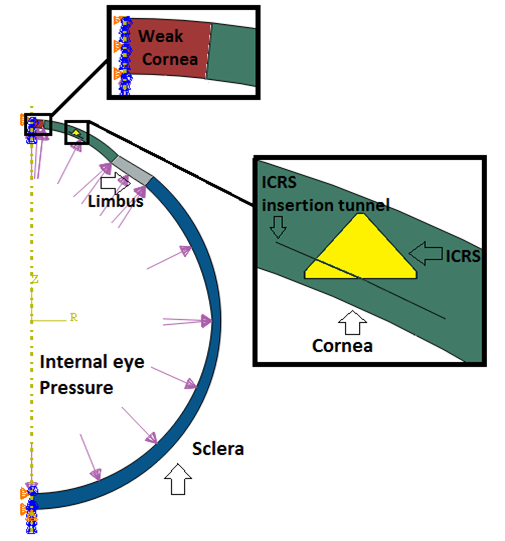- English
- فارسی
Biomechanical charactrization of cornea
The aim of this study is in two following research subjects:
1- To understand the biomechanical behavior of cornea and its effect on IOP measurement process.
The eye globe is one of the most complicated and important organs in the body. The cornea, as a transparent tissue in front of the eye globe, is the most important optical structure of the eye which reflects the light onto the retina. Small alternations from physiological states due to changes in the biomechanics of the cornea reduce its visual performance. Therefore, it is necessary to have more information about the biomechanics of eye and in particular the cornea. Additionally, more knowledge about the corneal biomechanics makes the relevant surgeries more effective. Aqueous humor, which is generated by ciliary bodies locating in the eye globe, causes the posterior surface of cornea to be under a constant mechanical stress. This mechanical stress is called intraocular pressure (IOP) and is measured by devices called tonometers. High values of IOP may cause eye diseases such as Glaucoma, so it is essential to assess eye conditions by measuring IOP. There are different types of tonometry devices, among which non-contact tonometries are considered in the present study. Non-contact tonometers, including ORA and Corvis ST, not only are used to estimate intraocular pressure (IOP) in clinical surveys but also are utilized to evaluate biomechanical properties of the cornea or anterior eye. In this thesis, a finite element model (FEM) is developed in order to study the eye globe behavior during IOP measurement process. Understanding the material properties of the eye and specially the cornea is the first essential step for the modeling purposes. To calculate the material properties of the cornea, images from cornea deformation due to the applied air jet were acquired from Corvis ST and were converted to corneal deformation profiles by image processing techniques. By excluding the eye globe rigid body movement (retraction) from the total eye displacement, pure deformation of the cornea is obtained and is used to estimate the corneal material properties. However, as for the cornea, a realistic material model is still a controversial issue; this study tried to make this clearer. To this aim, the corneal biomechanical response is investigated by using a four-element viscoelastic model called Burgers model, which is characterized by two sets of ex-vivo and in-vivo experimental data. In the first approach, by using creep test data from the literature, viscoelastic material properties are calculated by employing the least square method. In the second approach, corneal pure deformation was used to calculate the material properties of the viscoelastic model. By calculating the retardation time, contribution of the material viscosity during the test is estimated. Although the results of the both approaches are quantitatively different, they qualitatively show that viscosity effects do not have much contribution in the cornea response during dynamic tests. As it is obvious that the cornea behaves like a nonlinear elastic material, the Neo-Hookian hyperelastic material model is selected for the FEA. Then, by employing inverse finite element method, which is a combination of FEM and an optimization algorithm, cornea biomechanical properties are evaluated in order to reach cornea pure deformation. The influence of IOP on the estimated corneal material properties is also studied in order to investigate the sensitivity of the estimated material properties to the IOP. In a similar way and by employing a simple one-dimensional model, the biomechanical properties of the fat tissue located behind eye are determined by combining an ODE solver and an optimization algorithm in order to determine the eye globe movement. Combination of these two models forms a model for the whole eye globe with the ability to study the behavior of the cornea in tonometry tests. Since ORA tonometer is more popular than other tonometers in Iran, this tonometer was chosen to be studied by finite element modeling. The effects of maximum applied air pressure, IOP, and corneal geometry on the behavior of the cornea were studied by utilizing this model. Studies show that corneal hysteresis (CH) introduced by ORA is related to none of the investigated parameters. It was also shown that IOP is more sensible to the maximum displacement of corneal apex than to the applanation times. Accordingly, it is suggested to use displacement of the corneal apex as an indirect parameter for IOP measurement.

2- It is useful for surgeon for Intrastromal Ring Segment Implantation using FEA.
Implantation of Intrastromal Corneal Ring Segments (ICRSs) is a surgical method to flatten the anterior corneal surface which is cone shaped in a keratoconic cornea. In this study, a two-dimensional axis-symmetric Finite Element (FE) model has been developed to analyze the performance of ICRS for keratoconic cornea treatment. Ocular parts (cornea, limbus and sclera) are modeled with a combination of hyper-elastic and elastic material properties and triangular geometry for ICRS (named Ferrara). The performance of Ferrara ring implantation for different implant heights and optical zones were studied and compared with available clinical data. It was found that inserting a higher implants with smaller optical zone has more correction effect on keratoconus treatment. Moreover, this model is capable of predicting the implant performance for different extents of keratoconic disease.

